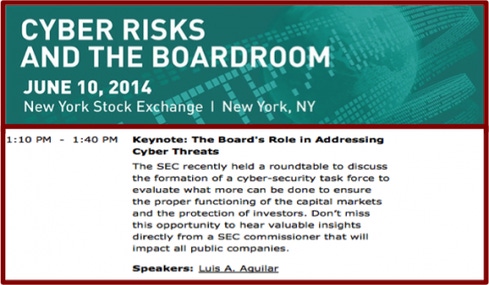The SEC is emerging as a key proponent of corporate cyber security responsibility and diligence. What does that mean for the CISO?

From major retail data breaches to the Heartbleed bug, 2014 is shaping up to be the year where cyber security becomes a high-level priority among businesses. The major events of the past months have also prompted increased attention from Washington, including both houses of Congress. Yet as cyber security bills languish in the halls of the Capitol, one government body is quickly positioning itself as a regulator of corporate cyber security: The Securities and Exchange Commission.
The SEC has been emerging as a key proponent of corporate cyber security responsibility and diligence. Last year, the regulatory body released an alert, calling on companies to shore up their networks and allocate resources to effectively confront cyberthreats. In March, SEC Commissioner Luis Aguilar echoed this sentiment by publicly stating that board members are responsible for the cyber security posture of their organizations.
Board-level oversight of cyber security issues is not a novel idea. Security professionals and commentators have been calling for cyber security to move out of IT departments and into the purview of top-level executive and board members for some time. Yet, the recent moves by the SEC show some preliminary movement toward future regulation that could hold companies (and their boards) accountable for the cyber security performance of their organizations. While specific regulations from the SEC around cyber issues don’t currently exist, the organization is pushing the issue. The Office of Compliance Inspections and Examinations will begin incorporating cyber security preparedness into mandatory examinations taken by entities that deal with securities, such as hedge funds.
Beyond compliance examinations, how will the SEC change security for an organization? It is impossible to say for sure, but it should be a wakeup call to board members who have not previously monitored the security of their companies. As Commissioner Aguilar aptly noted in a recent address at the New York Stock Exchange, “Boards are responsible for overseeing that the corporation has established appropriate risk management programs and for overseeing how management implements those programs.” While boards that implement these programs should be lauded, there is significant follow-through that comes with oversight of security.
For the practice of board oversight to become a reality, members need consistent metrics and benchmarks to provide a better view of security performance over time. While checkbox items such as adequate personnel, budget, and technology resources are highly important, board members need points of comparison and metrics that can be revisited time and time again. By defining a set of key performance indicators, boards can empower CISOs and security executives to better manage and mitigate cyber risks, which will change the perception of cyber security preparedness from being a black hole for budgets to that of a competitive differentiator.
The SEC is likely to continue to weigh in on the issue of cyber security, as failed network security can disrupt the functioning of capital markets. While concrete regulations may not be imminent, the questions raised by this governmental body bring up an important point: The cyber security performance of an organization is directly related to corporate governance. These issues can be viewed, no longer as “cyber” issues, but rather as business issues.
About the Author(s)
You May Also Like
The fuel in the new AI race: Data
April 23, 2024Securing Code in the Age of AI
April 24, 2024Beyond Spam Filters and Firewalls: Preventing Business Email Compromises in the Modern Enterprise
April 30, 2024Key Findings from the State of AppSec Report 2024
May 7, 2024Is AI Identifying Threats to Your Network?
May 14, 2024
Black Hat USA - August 3-8 - Learn More
August 3, 2024Cybersecurity's Hottest New Technologies: What You Need To Know
March 21, 2024




